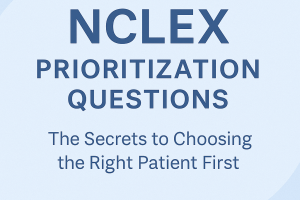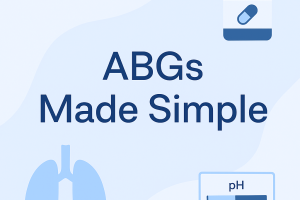Mastering Seizures and Epilepsy in Preparation for NCLEX Exam

Seizures and epilepsy are critical topics for the NCLEX exam. Understanding their pathophysiology, types, symptoms, diagnosis, and management is essential for providing effective nursing care. This blog post provides a comprehensive guide to help you prepare for the NCLEX exam.
What are Seizures and Epilepsy?
A seizure is a sudden, uncontrolled electrical disturbance in the brain, causing changes in behavior, movements, feelings, or levels of consciousness. Epilepsy is a neurological disorder characterized by recurrent, unprovoked seizures.
Pathophysiology
Seizures occur due to abnormal, excessive, or synchronous neuronal activity in the brain. Epilepsy may result from various underlying conditions, such as genetic factors, brain injuries, infections, or developmental disorders.
Types of Seizures
Focal (Partial) Seizures
- Focal Onset Aware Seizures (Simple Partial Seizures): Involves a specific area of the brain with no loss of consciousness. Symptoms may include jerking movements, sensory disturbances, or emotional changes.
- Focal Onset Impaired Awareness Seizures (Complex Partial Seizures): Involves a specific area of the brain with impaired consciousness. Symptoms may include automatisms (repetitive behaviors), confusion, or staring spells.
Generalized Seizures
- Absence Seizures: Characterized by brief lapses in awareness, staring, and subtle body movements (e.g., eye blinking).
- Tonic-Clonic Seizures (Grand Mal): Involves both tonic (stiffening) and clonic (jerking) phases, with loss of consciousness.
- Atonic Seizures: Sudden loss of muscle tone, leading to falls.
- Myoclonic Seizures: Brief, jerking movements of muscles or muscle groups.
- Tonic Seizures: Sustained muscle stiffening.
- Clonic Seizures: Repeated jerking movements.
Symptoms
- Aura: Sensory, motor, or emotional changes that precede a seizure.
- Altered Consciousness: Staring, unresponsiveness, or confusion.
- Motor Symptoms: Jerking movements, muscle stiffness, or twitching.
- Sensory Symptoms: Tingling, numbness, or visual disturbances.
- Autonomic Symptoms: Changes in heart rate, breathing, or sweating.
- Emotional Symptoms: Fear, anxiety, or deja vu.
Risk Factors
- Genetic Predisposition
- Brain Injuries: Trauma, stroke, or tumors.
- Infections: Meningitis, encephalitis, or brain abscesses.
- Developmental Disorders: Autism spectrum disorder or neurofibromatosis.
- Metabolic Imbalances: Hypoglycemia, hyponatremia, or hypocalcemia.
- Substance Abuse: Alcohol or drug use and withdrawal.
Diagnosis
- Medical History: Detailed account of seizure episodes, family history, and underlying conditions.
- Neurological Examination: Assessing motor and sensory function, reflexes, and cognitive abilities.
- Electroencephalogram (EEG): Recording of brain electrical activity to identify abnormal patterns.
- Brain Imaging: MRI or CT scans to detect structural abnormalities.
- Blood Tests: To identify metabolic or genetic causes.
- Lumbar Puncture: To check for infections or inflammatory conditions.
Management
Acute Management
- Safety Measures: Protecting the patient from injury during a seizure (e.g., cushioning the head, removing harmful objects).
- Airway Management: Ensuring an open airway and preventing aspiration.
- Medication: Administering benzodiazepines (e.g., lorazepam or diazepam) for prolonged seizures or status epilepticus.
Long-term Management
- Antiepileptic Drugs (AEDs): Medications to control seizures (e.g., phenytoin, valproate, levetiracetam).
- Surgical Interventions: For patients with drug-resistant epilepsy (e.g., lobectomy, lesionectomy, or corpus callosotomy).
- Vagus Nerve Stimulation (VNS): Implantable device to reduce seizure frequency.
- Ketogenic Diet: High-fat, low-carbohydrate diet to control seizures in some patients.
- Lifestyle Modifications: Stress management, adequate sleep, and avoidance of seizure triggers.
- Patient Education: Importance of medication adherence, recognizing seizure triggers, and safety measures.
Complications
- Status Epilepticus: Prolonged or repeated seizures without recovery in between, a medical emergency.
- Injury: Due to falls, burns, or accidents during a seizure.
- Sudden Unexpected Death in Epilepsy (SUDEP): Unexplained death in patients with epilepsy.
- Cognitive and Psychological Issues: Memory problems, depression, or anxiety.
NCLEX Preparation Tips for Seizures and Epilepsy
- Understand Pathophysiology: Be clear about how seizures occur and the mechanisms behind epilepsy.
- Memorize Key Symptoms: Recognize the symptoms of different types of seizures.
- Diagnostic Tools: Familiarize yourself with the diagnostic criteria and tests for seizures and epilepsy.
- Management Strategies: Know the acute and long-term management protocols for seizures and epilepsy.
- Complications: Be aware of potential complications and their interventions.
- Practice Questions: Utilize NCLEX practice questions focused on seizures and epilepsy to reinforce your knowledge and improve your test-taking skills.
Conclusion
Mastering the topic of Seizures and Epilepsy is crucial for success on the NCLEX exam. By understanding the pathophysiology, symptoms, diagnosis, and management of these conditions, you will be well-prepared to answer related questions and provide high-quality patient care. Keep studying, practicing, and applying your knowledge to ensure you excel in your nursing career.






